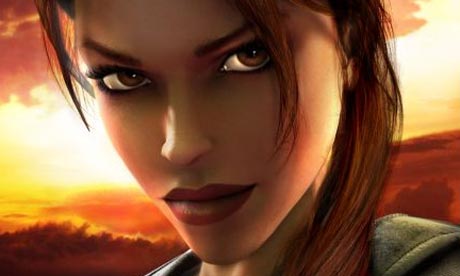
The Tomb Raider video game franchise, and its heroine Lara Croft, is 16 years, nine games, two films and at least one amusement park ride, old this year. Although Lara was originally best known for the remarkable size of her breasts – and that's still probably the first thing to spring to mind about her – she's grown into an interesting character, with plenty of adventures under her belt. And at the recent E3 conference developers Crystal Dynamics revealed a new, gritty version of Lara Croft's history – one that sees her bloodied, bruised, badly wounded, and forced to fight for her life against mercenaries, one of whom tries to rape her before she blows his head off.
The inclusion of the attempted rape scene raises some difficult questions. If the scene is playable, what exactly happens should the player fail? If it is not, why show it at all? Lara is already going through a lot – shipwreck, major injury, a friend's kidnapping, the threat of death – and adding sexual assault to the mix might just be over-egging the pudding.
Then there is the fact that rape is not a naturally occurring event like a rockfall, or a transformative one like a radioactive spider bite. In too much media, its use is a lazy shorthand that allows a writer to paint a bad guy as particularly bad, and a woman as particularly vulnerable (the genders are rarely reversed), without dealing with the consequences or meaning of such an act for any of the parties involved. That doesn't mean no storyteller or video game should ever tackle rape – of course they should, where a story demands it – but if the only reason to include sexual violence is to emphasise a woman's vulnerability or a man's evilness, then it's fair to question why a threat of murder is not enough.
The bigger question, in the case of Tomb Raider, is why the game's designers decided to make Lara Croft so vulnerable. In a recent interview with Kotaku, executive producer Ron Rosenberg said players want to protect Lara, and that the new game would break her down, put her through awful experiences, and make the players "root for her in a way that you might not root for a male character".
His statements take some unpacking, and for fans of the Tomb Raider series they're not encouraging. As a player, I don't remember having many problems projecting myself as Lara – and I don't particularly want an avatar in a game that needs protecting. Players aren't expected to want to protect Nathan Drake in Uncharted, or John Marston in Red Dead Redemption, or Max Payne – so why Lara? Rosenberg seems to suggest it's because she's female – and it's hard to see that as anything other than a sexist approach, an assumption that men can't lose themselves in stories with female protagonists and/or that female gamers simply don't exist.
He also says she's forced to suffer such horrors that she "literally turns into a cornered animal". I hope it turns out that Lara's been a werewolf all this time – but I suspect he means that her character and spirit come under such attack that she's reduced to fight-or-flight responses. The Lara Croft of previous games has generally been intelligent, witty, resourceful and ingenious, as well as athletic, strong and skilful. Lara has always been a pragmatic survivalist with a keen sense of adventure; to decide that she needs to be tortured in order to be able to kill goes against what we know of her history and personality so far.
The idea that Lara – like Samus from Metroid – should have an origin story in which she is weak in order to explain her strength is difficult to swallow. Male characters are generally permitted to be strong without needing a back story in which they are broken – why should female characters be different? Why do we need to protect Lara through an awful ordeal for her strength to make sense? Judging by the comments on Kotaku and elsewhere, I'm not the only one who shares these concerns.
It is rare that strong women characters get to be protagonists in video games – and that's part of the problem. If there were a multitude of women whose stories were told well – flawed, brilliant, good, evil, strong, weak and everything in between – the mischaracterisation of one would not have such an impact. Lara Croft has never been without design problems (or presumably back pain), but to adjust her appearance while smashing her characterisation into smithereens would rather miss the point of all the criticism. I'm hoping, but not expecting, that this is a savage case of mis-marketing and that Crystal Dynamics has made a well-written, sensitively done story, that doesn't turn an iconic female character into a helpless wreck in the name of an edgy reboot. We'll have to wait and see.
• Follow Comment is free on Twitter @commentisfree

